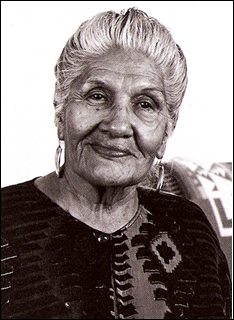Santa Fe Living Treasures – Elder Stories
<<Back to Treasures Index Rose NaranjoPOTTER AND MATRIARCHHonored January, 1994 | Rose NaranjoWidely known as a potter, her work treasured, collected, and honored, it is the traditions of pueblo and family that define the life of Santa Clara potter Rose Naranjo. The matriarch of a renowned family of artists, she raised ten children, eight of them born to her, and taught them all pottery making "so they could make a living." Rose saw to it that all her children, in a family that includes noted artists Michael Naranjo, Teresita Naranjo, Rina Swentzell, Jody Folwell, and Nora Naranjo-Morse, went to college. "I didn't have education," she said, "but I knew in the future they would need education. Every one of them got their college degree." Pottery links the Naranjos to the world outside the pueblo; it also binds the generations together. Born in 1917, Rose began working in clay in her teens. "Through the years, experience makes you good," she said. Raised by her grandmother Lupita, a midwife and medicine woman, Rose did not find out until her grandmother's death, when Rose was thirteen, that Lupita was not her mother. "Growing up was hard in those days," Rose remembered, "because we were so poor. She was the midwife, so when she went out to deliver a baby, we'd get food in exchange." At eighteen Rose married Michael Naranjo, a Southern Baptist minister. They lived in Taos for twenty-seven years, and Rose did missionary work alongside her husband, throughout the Southwest. They had been married fifty-nine years when he died in 1994. Raising her family kept Rose busy. "In my day, the pueblo is children," she said. "And housework." At last count, she had thirty-four grandchildren. "I have lots of them. I don't count them anymore." And at age eighty, Rose was still making her extraordinary pots, "when I need to pay bills." Rose's spiritual link to the pottery is very strong. With "good intention," her pots become an expression of her spirit, their making divinely guided from the digging of the clay to the firing, which she calls the "Judgment Day." Please see Volume 1 for complete text. |
